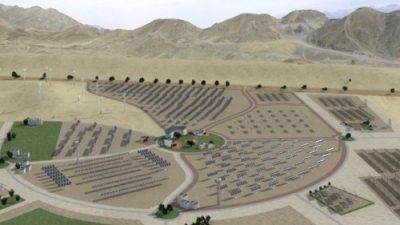 An unnamed client hired London-based Baharash Architecture to design a luxury home that could fully function off the energy grid. That’s a tall order for any residence in Abu Dhabi, now consider the challenges for one sited in the punishing clime of the hyper-arid Liwa Desert where summer temperatures top 100°F.
An unnamed client hired London-based Baharash Architecture to design a luxury home that could fully function off the energy grid. That’s a tall order for any residence in Abu Dhabi, now consider the challenges for one sited in the punishing clime of the hyper-arid Liwa Desert where summer temperatures top 100°F.
The star-shaped structure is modestly sized at about 6,000 square feet and will feature a living room, kitchen, two bedrooms, and central “great room”. Floor-to-ceiling glass walls permit panoramic views of the surrounding desert scenery. These fixed-glass “windows” will be electrochromic; mechanically tinted for shade and privacy with a press of a button that activates ionic motion within layers of glass, quickly changing the glass panels from clear to opaque.
Baharash Bagherian, founder of the design firm that bears his name, said in a statement, “We are seeing a new generation of Emiratis who are looking to lead a more sustainable lifestyle, in line with UAE’s vision to become one of the most sustainable countries in the world.”

The project press release did not define other sustainability features planned for the estimated $2 million vacation home. Simple technology for solar energy production can readily supply the building with all its daytime electricity needs, but there is no information about nighttime power consumption. Similarly, there is scant info on planned efficiencies for building systems and appliances. Will the structure be insulated to reduce heat gain and loss?
Eco-friendly construction is becoming prioritized in the UAE, specifically as relates to energy consumption, and the nation is a regional leader in renewable energy generation and municipal recycling. But in the Middle East, water is a greater priority. Many modern MENA municipalities still run on a pumped water procedure, where homes feed off personal water storage tanks which are periodically replenished from a city supply. Said differently, there isn’t always water when you turn on a tap. How will potable water be conveyed to this structure? And – on the flip side – how will sewage and waste be removed?
There’s an outside chance that green specifications are lost in translation; that press coverage of purportedly “green” buildings is selective, overlooking system technology and focusing on structural form instead. But by glossing over the fuller environmental impacts of a new building (how will it be accessed? does it need new roads? will it encourage more development in an otherwise pristine and ancient natural setting?), projects like these resemble little more than “lipstick on a pig”.
Photography courtesy of Baharash Architecture


